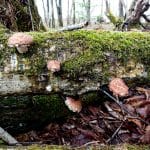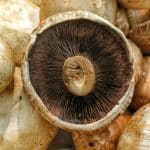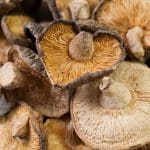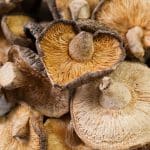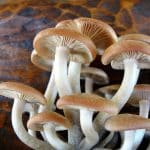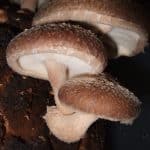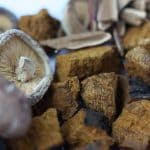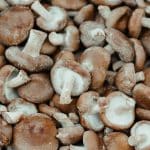Will Shiitake Mushroom Grow on Sawdust Substrate?
Yes, Shiitake mushrooms will grow on sawdust substrate. Shiitake mushrooms, when grown in sawdust substrate, will yield an average of three to five flushes of mushrooms. If you grow them on logs, they may give you fresh mushrooms every 5 weeks for 4-6 years! Shiitake mushrooms need high-cellulose materials, and they will grow on many log or sawdust substrates.
You can find our favorite supplements containing Shiitake Mushrooms on the following page of our website to learn more.
My preference is for sawdust from oak (or other hardwoods). In fact, shiitake mushrooms will grow on softwood sawdust which is usually much easier to get, but they do prefer a little extra nutrition, such as bran and sugar. Shiitake can grow on many other materials, and experimentation will show which are the best matches. Two common methods are effective in growing shiitake, one is using wooden logs, the other is spongy, man-made wooden logs packed into bags known as fruiting blocks.
The time and monetary upfront investment to grow your own shiitake mushrooms will pay off once you get good at it. Just consider how much it will cost you to purchase the quantity of mushrooms you can harvest at the grocery store.
Plus, you cannot beat the level of freshness you get when harvesting mushrooms at home. Growing your own mushrooms is a wonderful hobby, as well as an amazing learning experience for teaching kids about nature.
How do you grow shiitake mushroom in sawdust?
This is my favorite choice, relatively simple, and a lot quicker than using the natural logs which can take 3 months for the first fruiting. Yield is much higher, but flavor is less earthy, some find this flavor to be lower in quality compared to naturally grown shiitake from the logs. Regarding the substrate, I have used wood chips alone with success, but yields are probably far lower than when nutrients are added. A typical recipe could be: 95% hardwood sawdust, 3% rice bran, 1% wheat bran, and 1% gypsum, or 75% hardwood sawdust, 24% straw, and 1% gypsum.
You can also learn more via this video if you’re more of a visual learner:
Because of their slow growth, Shiitake base is better sterilized rather than pounded, though this is not as simple to make at home. However, I was quite successful using pasteurized substrate. Ideally, a substrate needs to be heated at 120°C under pressure for a couple hours to sterilize.
A pressure cooker can easily be used to accomplish this. I used a secondary container in the top area of my pressure cooker, a drilled biscuit tray, to add to capacity.
The sawdust needs to cool down below 30° C, or else it is at risk of killing off a youngling before it has started growing, leaving the sawdust overnight without opening the pressure cooker is a good option. Once cool, the spawn needs to be fully mixed in with the sawdust.
The better mixed this step is, the quicker the spawn can colonize the substrate. I have seen good inoculations as quick as in 14 days where the substrate was prepared in this way. I normally stir the substrate and grow the young manually, but it does require a clean environment, and always has a risk of contamination.
First, I sprayed my work surface with an antibacterial spray and then wiped. I also do the same with a metal tray that I am going to use to stir. Immediately prior to handling substrates or spawn, I thoroughly wash my hands, and once they are dry, use an alcohol-foaming agent to disinfect my hands surfaces. I then make sure that the tray is fully dry, and spread semi-sterilised wood chips on top.
The Spawn is added to it and thoroughly mixed. Any mass of spawn is broken down to its component parts. The more points of infection, the better, it is the amount of particles, not total mass, that will allow for faster colonization. Once it is mixed well, it needs to be loaded in a clean, preferably sterile, plastic bag. The bag may be tied loosely, or a ring from the collar and a piece of cotton wool may be used to allow for gas exchange.
The spawn run may take 1 – 3 months depending on the substrate, temperature, humidity, and how well prepared. The spawn run must be allowed to occur in a warm, room temperature, environment. It may need to add clean water occasionally to keep the substrate moist.
As a run nears completion, there will be a white coating starting to appear on the exterior of the substrate mass. This coat will help to protect against contamination, it will start 2-4 weeks after the culturing. The top layer will finally start developing lumps. These bumps can continue to grow into fruiting bodies, which will later turn into mushrooms, but many will be aborted.
Once the bumps begin to form, increase the airflow by opening up the bag and/or increasing ventilation, allowing for a bit of reddish/brown coloration on the surface. When about a third of the surface has turned brown meaning the coating is solidifying, remove the plastic bag entirely. The goal at this point is to raise oxygen levels on the surface so that it will mature.
Shiitakes can be shocked using various methods. Physical shock is one of the inducers, soaking in cold water for 48 hours is another.
At the same time, some light needs to be present. When a fungus has fruited (7-14 days), cut close to the surface. Do not pull out the unit, as this may cause injury leading to an infection.
Once you get the fruit on the block, go into recovery. Reduce the humidity (70%) and increase temperature (20-30° C) during the recovery phase, to allow the block to heal (7-21 days). At the end of this stage, move on to the shock phase, which restarts the growth, but also (importantly) refills the water stored in the blocks, which will be needed to produce the new mushrooms. The blocks will produce about 6 times, by the end, the mushrooms will be smaller, producing lower yields.
Learn more:







